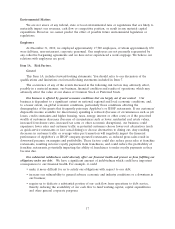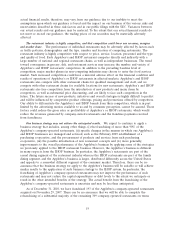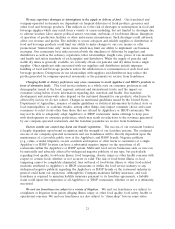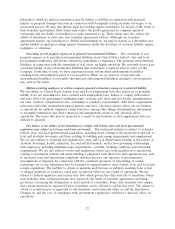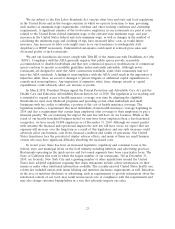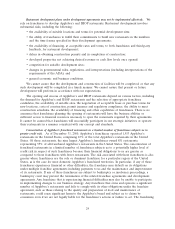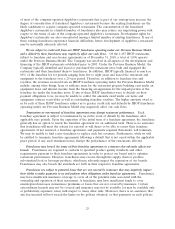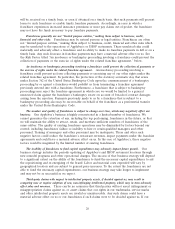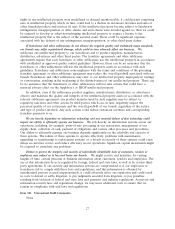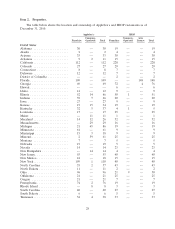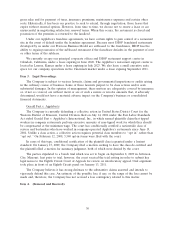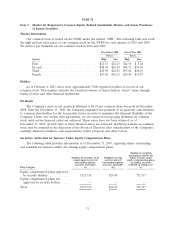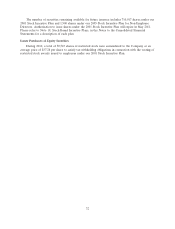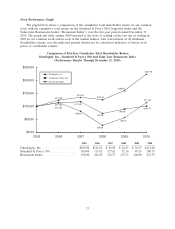IHOP 2010 Annual Report Download - page 41
Download and view the complete annual report
Please find page 41 of the 2010 IHOP annual report below. You can navigate through the pages in the report by either clicking on the pages listed below, or by using the keyword search tool below to find specific information within the annual report.of most of the company-operated Applebee’s restaurants that is part of our strategy may increase the
degree of concentration of franchised Applebee’s restaurants because the existing franchisees are the
likely candidates to acquire company-operated restaurants. The concentration of the franchised
Applebee’s restaurants in a limited number of franchisees also may reduce our negotiating power with
respect to the terms of sale of the company-operated Applebee’s restaurants. Development rights for
Applebee’s restaurants are also concentrated among a limited number of existing franchisees. If any of
these existing franchisees experience financial difficulties, future development of Applebee’s restaurant
may be materially adversely affected.
We are subject to credit risk from our IHOP franchisees operating under our Previous Business Model,
and a default by these franchisees may negatively affect our cash flows. Of the 1,493 IHOP restaurants
subject to franchise and area license agreements as of December 31, 2010, a total of 1,096 operate
under the Previous Business Model. The Company was involved in all aspects of the development and
financing of the IHOP restaurants established prior to 2003. Under the Previous Business Model, the
Company typically identified and leased or purchased the restaurant sites, built and equipped the
restaurants and then franchised them to franchisees. In addition, IHOP typically financed as much as
80% of the franchise fee for periods ranging from five to eight years and leased the restaurant and
equipment to the franchisee over a 25-year period. Therefore, in addition to franchise fees and
royalties, the revenues received from an IHOP franchisee operating under the Previous Business Model
include, among other things, lease or sublease rents for the restaurant property building, rent under an
equipment lease and interest income from the financing arrangements for the unpaid portion of the
franchise fee under the franchise notes. If any of these IHOP franchisees were to default on their
payment obligations to us, we may be unable to collect the amounts owed under our notes and
equipment contract receivables as well as outstanding franchise royalties. The higher amounts owed to
us by each of these IHOP franchisees subject us to greater credit risk and defaults by IHOP franchisees
operating under our Previous Business Model may negatively affect our cash flows.
Termination or non-renewal of franchise agreements may disrupt restaurant performance. Each
franchise agreement is subject to termination by us in the event of default by the franchisee after
applicable cure periods. Upon the expiration of the initial term of a franchise agreement, the franchisee
generally has an option to renew the franchise agreement for an additional term. There is no assurance
that franchisees will meet the criteria for renewal or will desire or be able to renew their franchise
agreements. If not renewed, a franchise agreement, and payments required thereunder, will terminate.
We may be unable to find a new franchisee to replace such lost revenues. Furthermore, while we will
be entitled to terminate franchise agreements following a default that is not cured within the applicable
grace period, if any, such termination may disrupt the performance of the restaurants affected.
Franchisees may breach the terms of their franchise agreements in a manner that adversely affects our
brands. Franchisees are required to conform to specified product quality standards and other
requirements pursuant to their franchise agreements in order to protect our brand and to optimize
restaurant performance. However, franchisees may receive through the supply chain or produce
sub-standard food or beverage products, which may adversely impact the reputation of our brands.
Franchisees may also breach the standards set forth in their respective franchise agreements.
Franchisees are subject to potential losses that are not covered by insurance that may negatively impact
their ability to make payments to us and perform other obligations under franchise agreements. Franchisees
may have insufficient insurance coverage to cover all of the potential risks associated with the
ownership and operation of their restaurants. A franchisee may have insufficient funds to cover
unanticipated increases in insurance premiums or losses that are not covered by insurance. Certain
extraordinary hazards may not be covered and insurance may not be available (or may be available only
at prohibitively expensive rates) with respect to many other risks. Moreover, there is no assurance that
any loss incurred will not exceed the limits on the policies obtained, or that payments on such policies
25




